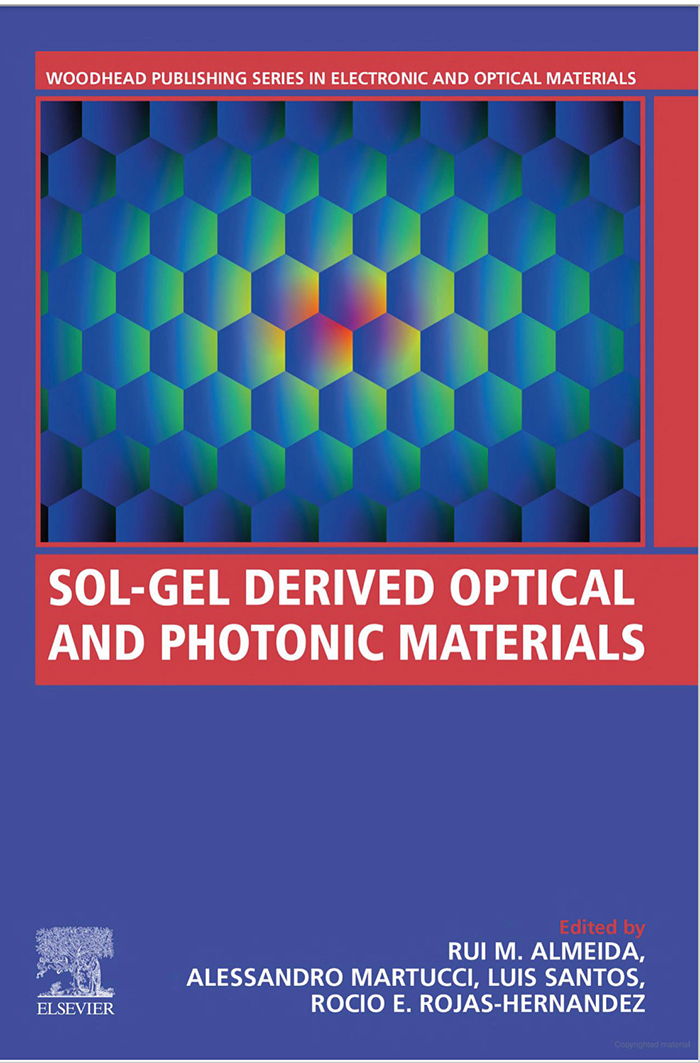New Book Highlights Sol-Gel Processing’s Impact on Optics and Photonic Materials
February 8, 2021
When editors were planning a new book on optical materials made via sol-gel processing, they contacted LLNL to review the use of this chemical route for the fabrication of anti-reflective (AR) coatings used in high energy/high power lasers.
That was about two years ago and led LLNL scientists Tayyab Suratwala, Pam Whitman, and Marcus Monticelli to write the first chapter that’s spotlighted in the just-released book, Sol-Gel Derived Optical and Photonic Materials.
 Three LLNL scientists wrote the first chapter of this new book. Credit: Elsevier.
Three LLNL scientists wrote the first chapter of this new book. Credit: Elsevier. The chapter, titled “Sol-Gel Derived Anti-Reflective Coatings for High Fluence Lasers,” reviews the requirements and design for AR coatings on laser optics, the sol-gel synthesis process, coating methods and post treatments, coating stability, and laser-damage performance.
“The thing that is so amazing about this coating technology is that it has an incredibly high laser damage resistance—much more than any of the other coating technologies that were out there,” said Suratwala, program director for Optics and Materials Science & Technology in the NIF & Photon Science Directorate. “As a result, this type of coating has survived many decades of use spanning several generations of high power and energy lasers including Nova, Beamlet, and NIF.”
Sol-gel derived AR coatings have been used on glass and crystal optics in high power and energy laser systems for more than 30 years and have been used in more than 100,000 half-meter-scale optics.
Colloidal silica made by the sol-gel process was first used by LLNL’s Ian Thomas for AR coatings in 1986. Sol-gel, more specifically the Stöber process, is a solution chemistry method that allows for fabricating very small (20-nanometer), porous silica colloids that can be laid down onto optical surfaces with controlled thickness and index.
Sol-gel’s advantages include an appropriate refractive index, which provides high-efficiency anti-reflection; high chemical purity, which results in high laser-damage resistance; and relatively low-cost synthesis and coating processes.
These AR coatings have unique requirements: high transmission and low scatter at the desired wavelengths, high-transmission spatial uniformity, high coating environmental stability, and high laser-damage resistance.
The sol-gel process has been used in other optical applications such as solar panels, cathode-ray tubes, electrochromic mirrors, self-cleaning windows, and lasers. Sol-gel derived AR coatings are widely used on optics, especially for high power and energy laser systems such as NIF.
After the original sol-gel formulation for the AR coatings, an important variant was later developed by modifying the silica colloid surface with methyl groups, making the colloid hydrophobic instead of hydrophilic. This expanded its use as AR coatings on other NIF optics, such as hydrophilic potassium dihydrogen phosphate (KDP) crystals, providing improved chemical stability, and on fused silica grating debris shields, providing more stability in gaseous environments (see “Next-Generation NIF Optics Boost Energy and Limit Damage”).
The book’s editors said it is the first of its type to focus on optical and photonic sol-gel derived materials and provides scientists and engineers with an important tool by updating advances in the evolving field of optical and photonic materials, components, and devices.
The 16-chapter book also covers self-cleaning coatings, plutonic crystals, hybrid materials such as glass and plastic, additives, gas sensors, and optical fibers.
Suratwala, Whitman, and Monticelli credited the Lab’s Diana VanBlarcom, Tony Wang, and Gabe Davalos for providing absorption-isotherm, laser-damage, and atomic force microscopy characterization, and Margaret Davis for assistance in preparing the chapter.
Sol-Gel Derived Optical and Photonic Materials is part of the Woodhead Publishing Series in Electronic and Optical Materials and is published by Elsevier.
—Jon Kawamoto
Follow us on Twitter: @lasers_llnl



